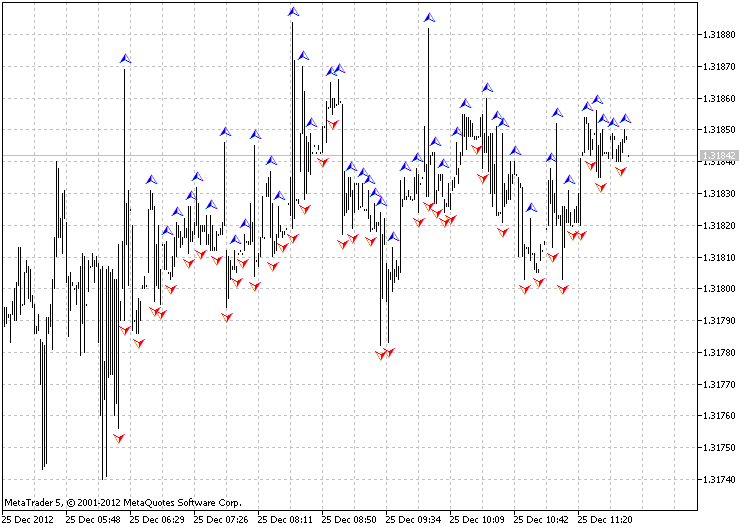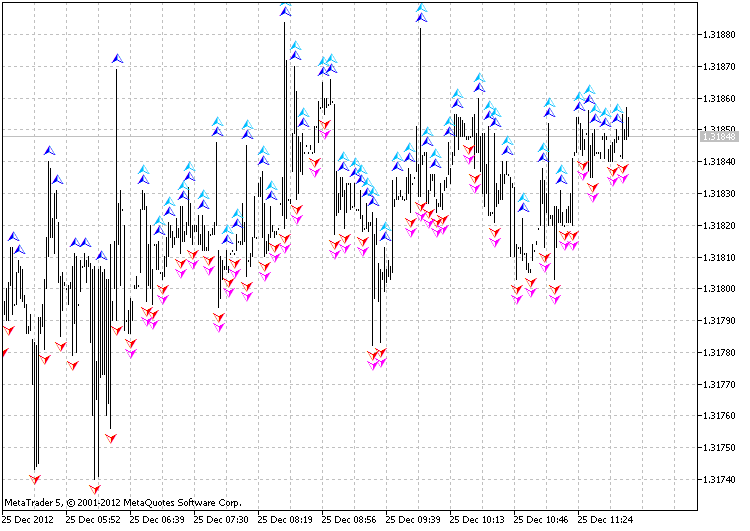Join our fan page
- Views:
- 8348
- Rating:
- Published:
- Updated:
-
Need a robot or indicator based on this code? Order it on Freelance Go to Freelance
Description
The CFractalsOnRingBuffer is designed for calculation of the Fractals technical indicator (Fractals) using the algorithm of the ring buffer.
Declaration
class CFractalsOnRingBufferTitle
#include <IncOnRingBuffer\CFractalsOnRingBuffer.mqh>File of the CFractalsOnRingBuffer.mqh must be placed in the IncOnRingBuffer folder that need to be established in MQL5\Include\. Two files with the examples used by the class from this folder are attached to the description. File with the class of the ring buffer also must be in this folder.
Class methods
//--- initialization method: bool Init( // if error it returns false, if success - true int bars_right = 2, // the number of bars to the right from the extremum int bars_left = 2, // the number of bars to the left from the extremum int size_buffer = 256, // the size of the ring buffer bool as_series = false // true, if a time series, otherwise - false );
//--- the method of calculation based on a time series or the indicator buffers: int MainOnArray( // returns the number of processed elements const int rates_total, // the size of the arrays const int prev_calculated, // processed elements on the previous call const double& high[], // the array of the maximum const double& low[], // the array of the minimum );
//--- the method of calculation of fractal based on a separate series elements of the array high[] double MainOnHigh( // returns the value of up fractal for the index-bars_right element (bar) const int rates_total, // the size of the array const int prev_calculated, // processed elements of the array const int begin, // from where the significant data of the array starts const double high, // the current bar maximum const int index // the current element (bar) index );
//--- the method of calculation of down fractal based on a separate series elements of the array low[] double MainOnLow( // returns down fractal value for the index-bars_right element (bar) const int rates_total, // the size of the array const int prev_calculated, // processed elements of the array const int begin, // from where the significant data of the array starts const double low, // the current bar minimum, the current array element maximum const int index // the current element (bar) index );
//--- the methods of access to the data: int BarsRequired(); // Returns the necessary number of bars to draw the indicator string Name(); // Returns the name of the indicator string NameUpper() // Returns the name of up fractals string NameLower() // Returns the name of down fractals int BarsRight() // Returns the number of bars to the right from the extremum int BarsLeft() // Returns the number of bars to the left from the extremum int Size(); // Returns the size of the ring buffer
To get the calculated data of the indicator from the ring buffers is possible as from the usual array. For example:
//--- the class with the methods of calculation of the Fractals indicator: #include <IncOnRingBuffer\CFractalsOnRingBuffer.mqh> CFractalsOnRingBuffer fractals; ... //+------------------------------------------------------------------+ //| Custom indicator iteration function | //+------------------------------------------------------------------+ int OnCalculate(const int rates_total, const int prev_calculated, const datetime& time[], const double& open[], const double& high[], const double& low[], const double& close[], const long& tick_volume[], const long& volume[], const int& spread[]) { //--- calculation of the indicator based on the price time series: fractals.MainOnArray(rates_total,prev_calculated,high,low); ... //--- use the data from the ring buffers "fractals", // for example, copy the data in the indicator buffer: for(int i=start;i<rates_total-BarsRight && !IsStopped();i++) { UpperBuffer[i] = fractals.upper[rates_total-1-i]; // up fractals LowerBuffer[i] = fractals.lower[rates_total-1-i]; // down fractals } ... //--- return value of prev_calculated for next call: return(rates_total); }
Please note that indexing in the ring buffers is the same as in the time series.
Examples
- The indicator calculates the Test_Fractals_OnArrayRB.mq5 file on the basis of the price time series. The MainOnArray() method application is demonstrated.
- The Test_Fractals_OnValueRB.mq5 file demonstrates the use of the MainOnValue() method. At first the Fractals indicator is calculated and drawn. Then on the basis of this indicator ring buffer one more Fractals is drawn.
The result of the work of the Test_Fractals_OnArrayRB.mq5 with the size of the ring buffer of 256 elements When writing code the developments of MetaQuotes Software Corp., Integer and GODZILLA were used.

The result of the work of the Test_Fractals_OnValueRB.mq5 with the size of the ring buffer of 256 elements
Translated from Russian by MetaQuotes Ltd.
Original code: https://www.mql5.com/ru/code/1422
 SuperWoodiesCCI
SuperWoodiesCCI
The indicator realizes the trading strategy using the CCI
 The class for drawing the TEMA using the ring buffer
The class for drawing the TEMA using the ring buffer
The class is designed for calculation of the technical indicator Triple Exponential Moving Average (Triple Exponential Moving Average, TEMA) using the algorithm of the ring buffer.
 Exp_CandleStop_Trailing
Exp_CandleStop_Trailing
The Expert Advisor moves Stop Loss of the open position along the border of the channel built using CandleStop indicator
 Exp_StepSto_v1
Exp_StepSto_v1
The Expert Advisor drawn on the basis of the signals of the StepSto_v1 stochastic oscillator